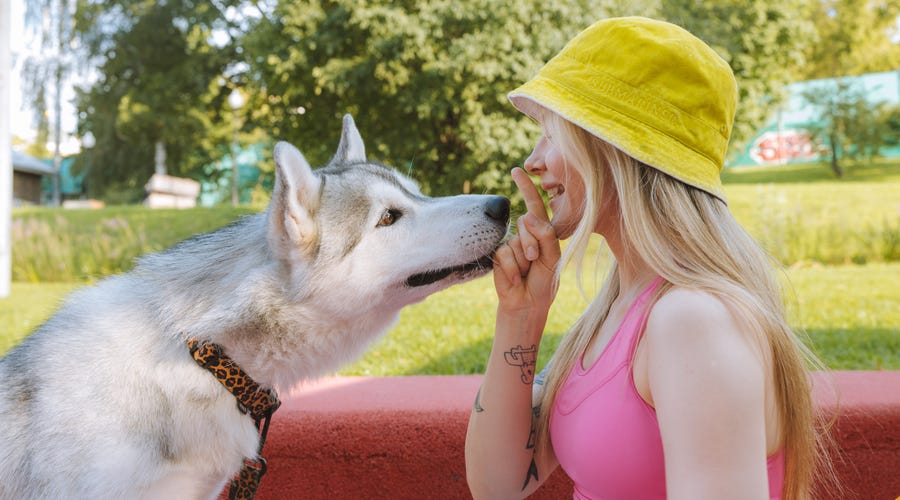
50 top dog commands in German to teach your fur-ever friend
Author: Marie Schmoll
You’re invited to a party in a German-speaking country but you’re the kind of person who always ends up talking mostly to the dog at social gatherings? Well, time to learn how to talk to dogs in German!
Whether you’re cracking jokes with a parrot, or telling your cat how purrfectly beautiful she is - animals are great conversation partners. So I don’t blame you for heading straight towards the fur baby of the house and introducing yourself.
If you’re meeting a dog who grew up in Germany and has been trained in German, it’s nice to know some German dog commands like “Sitz” (sit) and “Gib Pfötchen” (shake hands - or literally: give paw).
Even if you’re meeting American dogs, there’s a chance they might understand some German training commands for dogs because people love teaching their dogs German. One reason for this is that many of the most popular dog breeds are German including the German Shepherd, Doberman, Dachshund, Boxer, Schnauzer and Rottweiler. So it seems kind of polite to make the effort and speak their “native tongue”.
There’s another reason why teaching your dog German just makes sense: As a German language learner, you’ll know that German can sound incredibly authoritarian. Maybe there’s a better chance your dog will actually follow your commands if they sound like “Sitz! Platz! Bei Fuß!”

German dog commands
Dogs communicate through body language, facial expressions, tail wagging and of course through barking.
The first word you might want to remember when you’re trying to communicate with a German-speaking dog is “wau” or “wuff”, German for “wooff” - but there are a lot more!
Basic commands
If you’re teaching your dog German commands, it’s best to start with the basics. The most important dog commands are all about safety, like “sit”, “stay” or “heel”. After all, you don’t want your puppers to run into traffic or get into any other dangerous situation. So it’s useful to teach them these basic commands and make sure they listen to you.

| English | German | IPA | Purpose |
| Sit | Sitz | [zɪts] | Instructs the dog to lower its hindquarters onto the ground, maintaining a seated position until given further instruction |
| Stay | Bleib | [blaɪ̯p] | Tells the dog to remain in its current location and position until given another command |
| Good job | Bravo | [ˈbʁaːvoː] | Used to praise your pup - typically to reinforce behavior after they’ve followed another command correctly |
| Good dog | Braver Hund | [ˈbʁaːfɐ ˈhʊnt] | Used as general praise and is guaranteed to make some tails wiggle |
| Shake hands | Gib Pfote | [ɡɪp ˈpfɔːtə] | Asks your dog to raise a paw and place it in your hand, as if shaking hands |
| Drop, Drop it | Aus | [aʊ̯s] | Commands the dog to release whatever it's holding in its mouth |
| Heel | Bei Fuß | [baɪ̯ ˈfuːs] | The command or skill "heel" simply means that the dog must walk directly next to you instead of behind or in front of you |
| Come | Komm | [kɔm] | Calls your dog to return to you or follow you |
| Here | Hier | [hiːɐ] | Similar to "come", telling the dog to come with you |
| Go | Los | [loːs] | Gives your dog permission to move or run |
| Down | Platz | [plats] | Tells your dog to lay down on the ground |
| Stand | Steh | [ʃteː] | Asks your dog to rise to its feet from a sitting or lying position |
| Roll over | Rolle | [ʁɔlə] | Tells your dog to lie down, roll over, and end up standing on the other side |
| Fetch | Hol | [hoːl] | Tells your dog to go and get something that you have thrown or pointed at |
| Fetch the stick | Hol Stöckchen | [hoːl ˈʃtœkçən] | Specific command telling your dog to go and get a thrown stick |
| Speak | Gib Laut | [ɡɪp laʊ̯t] | Tells your dog to make noise, usually one bark |
| Jump | Hopp | [hɔp] | Tells your dog to leap over an obstacle or just jump into the air |
| Run | Lauf | [laʊ̯f] | Encourages your dog to stretch their paws and run free |
| No | Nein | [naɪ̯n] | General command used to prevent any unwanted behavior - like when they’re eyeing the ice-cream cone the neighbor’s toddler is holding |
| Stop | Halt | [halt] | That’s what you yell when the dog leaps for the cone anyway |
| Slow | Langsam | [ˈlaŋzam] | Instructs your dog to reduce speed |
| Faster | Schneller | [ˈʃnɛlɐ] | Encourages your dog to increase speed |
| Straight ahead | Geradeaus | [ɡəˈʁaːtəˌʔaʊ̯s] | Directs your dog to continue moving forward |
| Right | Rechts | [ʁɛçts] | Directs your dog to go right |
| Left | Links | [lɪŋks] | Directs your dog to go left |
| Wait | Warte | [ˈvaʁtə] | This will let your dog know you want them to wait for you |
| Onwards | Vorwärts | [ˈfoːɐ̯vɛʁts] | Tells your dog to keep going |
Cute and creative commands
Just like we tend to develop our own secret language with our loved ones, the way we speak to our pets is also extremely unique and specific to our relationship with them. Some may exclusively speak in their high-pitched “baby voice” when addressing their furry little Snugglepuff, while others come up with a number of their own unique commands. Here’s some inspiration:

| English | German | IPA | Purpose |
| Give a little kiss | Gib Küsschen | [ɡɪp ˈkʏsçən] | You can use this either to have your dog “kiss” your hand - or to actually let them lick your face if your love goes that deep |
| Dance | Tanz | [tants] | A cute way to ask your dog to stand on their hind legs |
| Twirl | Dreh dich | [dʁeː dɪç] | This asks your dog to turn around, also a great dance move! |
| Swim | Schwimm | [ʃvɪm] | A helpful command when you’re taking your dog to the beach or a lake |
| Crawl | Kriech | [kʁiːç] | Use this if you want your dog to crawl underneath a fence or another obstacle |
| Hide | Versteck dich | [fɛɐ̯ˈʃtɛk dɪç] | This command can be used to play hide-and-seek with your dog |
| Angel, angel, fly | Engelchen, Engelchen, flieg | [ˈɛŋəlçən ˈɛŋəlçən fliːk] | German parents love to say this when picking up their kids and making them “fly” by lifting them through the air - definitely also works for your doggo! |
| Where’s your ball? | Wo ist dein Ball? | [voː ɪst daɪ̯n bal] | Playful command encouraging your dog to go and look for their ball |
| Where’s your tail? | Wo ist dein Schwanz? | [voː ɪst daɪ̯n [ʃvant͡s] | Playful command encouraging your dog to chase their own tail |
| Cuddle time | Kuschelzeit | [ˈkʊʃəlˌtsaɪ̯t] | Lets your fur baby know you’re ready for cuddles! |
| Treat | Leckerli | [ˈlɛkɐli] | This will soon be your dog’s favorite word if you use it right before you pull out those treats |
| Urgh | Pfui | [pfʊɪ̯] | You can use this command to discourage them from rolling in the dirt or sticking their nose into something not so pretty |
| Sniff | Schnüffel | [ˈʃnʏfəl] | Lets your dog know when you’ve discovered a scent they might be interested in. This can also be a great reminder for your dog to stop and smell the roses when you feel like they’re going to fast! |
| Howl | Heule | [ˈhɔɪ̯lə] | This can be used to make that little wolf go “awoo” |
| Sleep | Schlaf | [ʃlaf] | Sometimes dogs can get a little restless - this might get them to settle down or actually even fall asleep eventually |
Police dog training commands
For most people teaching your dogs commands in German is just for fun - but for police officers, this common practice actually has some serious advantages. Since German isn’t commonly spoken, it’s harder for outsiders to control dogs that are trained in German. This can be helpful if a police dog, commonly known as K9 dog, is supposed to hold down a criminal but the criminal is trying to confuse the dog with English commands like “no” or “stop”.
Here are some training commands specifically for police dogs - Please don’t teach your dogs “Fass”. We don’t want them to attack anyone!

| English | German | IPA | Purpose |
| Guard | Wach; Pass auf | [vax; pas ʔaʊ̯f] | Commands the dog to protect a specific area or person |
| Attack | Fass | [fas] | A command given to a police dog to apprehend a suspect, typically by biting and holding on, reserved for situations where the suspect is seen as a significant threat |
| Retrieve | Bring | [bʁɪŋk] | Commands the police dog to pick up an item with their mouth and bring it back to the handler, such as evidence or items of interest during a search |
| Search | Such; Revier (for area search) | [zʊχ; [ʁeˈviːɐ̯] | Instructs a police dog to look for something specific like a missing person, drugs, explosives, or evidence at a crime scene. The dog is trained to signal its handler like barking, lying down, pointing with its nose when it has located the target |
| Back | Platz; Zurück | [plats; tsuːˈʁʏk] | Instructs the dog to walk backwards, typically for crowd control purposes |
| Quiet | Ruhig; Aus | [ˈʁuːɪ̯ç; ʔaʊ̯s] | Tells the dog to stop barking, which is especially important during covert operations |
| Alert | Anzeigen | [ˈanˌʦaɪ̯ɡŋ̍] | This is used to command a dog to signal when they have found something |
| Track | Fährte; Spur | [ˈfɛʁtə; ʃpuːɐ̯] | Signals the dog to follow a scent trail |
Meet the most famous German Shepard dog
Kommissar Rex (Inspector Rex) is an Austrian police comedy-drama television series following the German Shepherd police dog Rex and his partner Richard, who work together for the homicide unit of the Vienna Kriminalpolizei.
The story of INSPECTOR REX, the Most Famous POLICE DOG in Europe 🐕👮♂️
Rex is fluffy, loyal, and extremely clever. Being able to communicate with his partner is crucial for solving crimes. The original dog who played Rex, called Santo von Haus Ziegelmeye in real life, did an incredible job learning commands, which was key to following the script.
From woofs to words
In 2004 the Science Magazine published a study about a border Collie called Rico who was able to understand over 200 words, most of which were related to toys and other objects. He was able to learn all these words through a process known as "fast mapping," which is similar to the way human children learn language. It involves guessing the meaning of a word based on its association with familiar words. This study showed how sophisticated the way dogs learn language. They’re able to understand and process language similar to human toddlers. Now we know why we instinctively talk to dogs like they’re our little babies!
200 words are a lot but who knows - maybe your dog can break the record? Head over to our German Language Blog to find more words to teach your German dog!


